The Houston Port region is one of the most influential industrial and logistic bases in the world. The geographic location provides global access for both goods and people. From Port Houston to a host of multi-national entities doing business around the clock, the Houston Port region is where business connects to the world.
By Chad Carson – Economic Alliance Houston Port Region
Several factors make the region unique, including being the largest petrochemical complex and the nation’s busiest port, a powerhouse largely due to a business-friendly climate as well as access to world-class infrastructure, and a talented workforce that crosses production, maritime, and an array of logistic expertise. Direct access to the Houston ship channel and numerous logistical and distribution channels makes this an ideal hub for companies that need worldwide distribution for their products.
There is no blueprint for how to strategize to improve the region’s economic development activities/assets, transportation infrastructure, workforce development entities, and investment protections. This is where the Economic Alliance Houston Port Region steps in as the convening entity in identifying, prioritizing, and promoting issues of Houston Port region significance, with a mission to grow a vibrant regional economy.
It is the individuals of this region, its members, companies, partners, and municipalities, that convene and do the work to advance the Houston Port region globally.
Operating in the most sought-after region in the world for petrochemical, maritime, logistics, and manufacturing operations, talent, and assets, the Houston Ship Channel is one of the largest growth engines of economic opportunity. The economic benefit in the Houston Port region is nearly 7-fold regarding businesses and workers.
In Texas, it helps create 1.3 million jobs and 3.2 million jobs in the U.S. as a whole. The Houston ship channel is a priority based on the economic impact and the unique needs that come along with sustaining investment activity. The structure of Economic Alliance consists of an Executive Board, an Elected Board, and eight initiative chairs supported by members through their direct involvement. The staff of seven works to carry out the directives of each of these bodies in the most efficient and effective way possible. Since 2008, Economic Alliance has supported 77 Project Wins – five economic development projects a year that have shown a direct impact of USD $ 17.8B in Capital Investment and 3,856 jobs created.
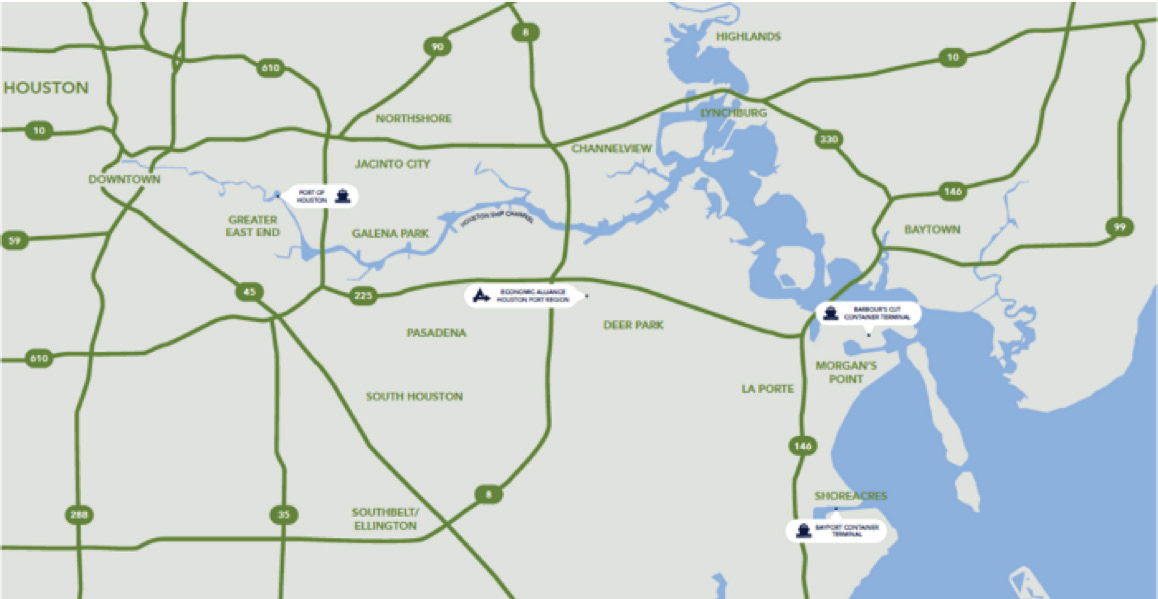
Houston Port Region – Economic Engine
The Houston Ship Channel and its more than 200 public and private terminals, collectively known as Port Houston, is the nation’s largest port for waterborne tonnage and an essential economic engine for the Houston region, the state of Texas, and the U.S.
Port Houston container volume dipped in January. Container twenty-foot equivalent units (TEUs) decreased by 1% compared to last January, with 319,990 TEUs for the first month of 2023, down 3,437 TEUs from the same period in 2022.
Loaded imports were down 6%, but total imports, including empty import containers, were up 5%, buoyed by a surge in empty containers repositioned to Houston to support a strong start in export bookings.
Due to increased resin demand in January, Port Houston saw significant growth in loaded exports, rising by 31% compared to last year to 113,875 TEUs for the month.
Port Houston is the top resin port in the nation, and exports of container cargo with polymers and other petrochemical products remain strong and the port will continue to make investments in facilities to handle future growth.
Steel imports at Port Houston are also off to a strong start for the year and are up 17% in January compared to January 2022 at 514,024 tons for the month.
The outlook is strong for container imports via Port Houston, with additional distribution centers ensuring continued economic growth for the region.
The impacts of the historic global supply chain demand are beginning to disappear, and the vessel queue is now reduced to single digits and will likely be caught up in 2023.
The long-term container growth in Houston is, however, extremely favorable. Retailers continue to invest in distribution centers in our region that are served through our Port. The export of petrochemical commodities continues to rebound as well.
Port Houston Improvements and Investments – Project 11
Although the import demand in the U.S. appears to be softening, the Port has not seen any slowing in Houston in recent months and is handling record amounts of cargo. Port Houston remains committed to the efficiency of their facilities and is making critical investments to stay well in front of demand both on the waterside and the terminal side.
Accommodating bigger ships is part of the reason Port Houston has advocated for Project 11. The deepening and widening of the channel is a USD $1 billion commitment to the growing economy, the generation of more jobs in the region, and the safety of nearly 20,000 vessels transiting the Houston Ship Channel every year.
The multi-year, multi-segment project includes widening parts of the channel to 700 feet and deepening others to 46 1/2 feet. Primary objectives include improving draft for larger vessels and giving them more room to maneuver, which lessens the need to play what ship pilots call ‘Texas Chicken’.

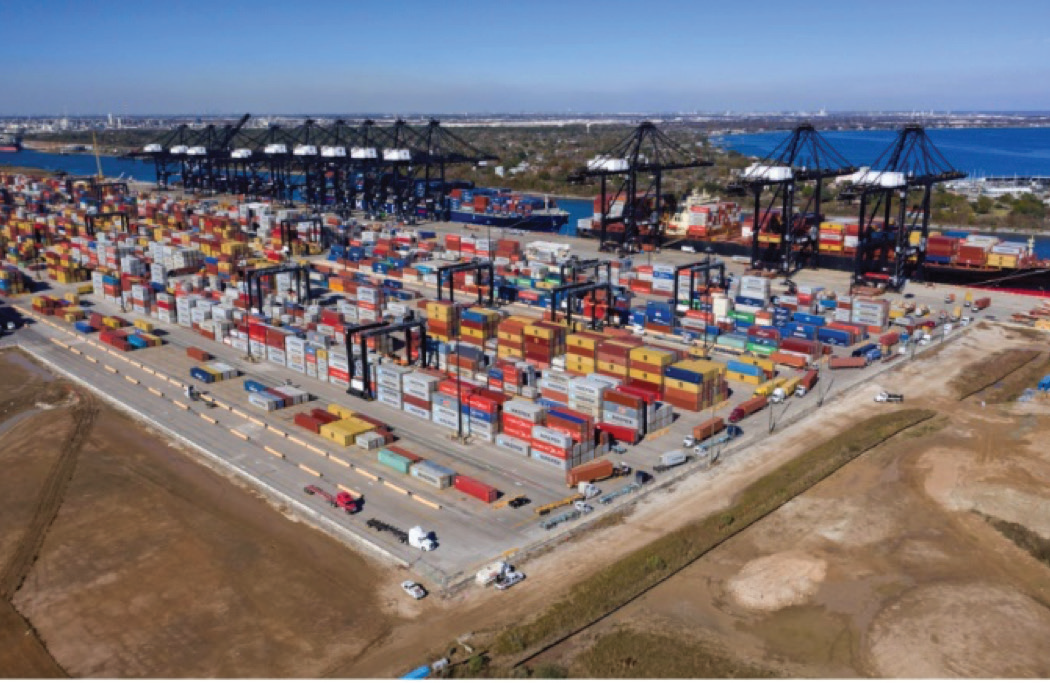
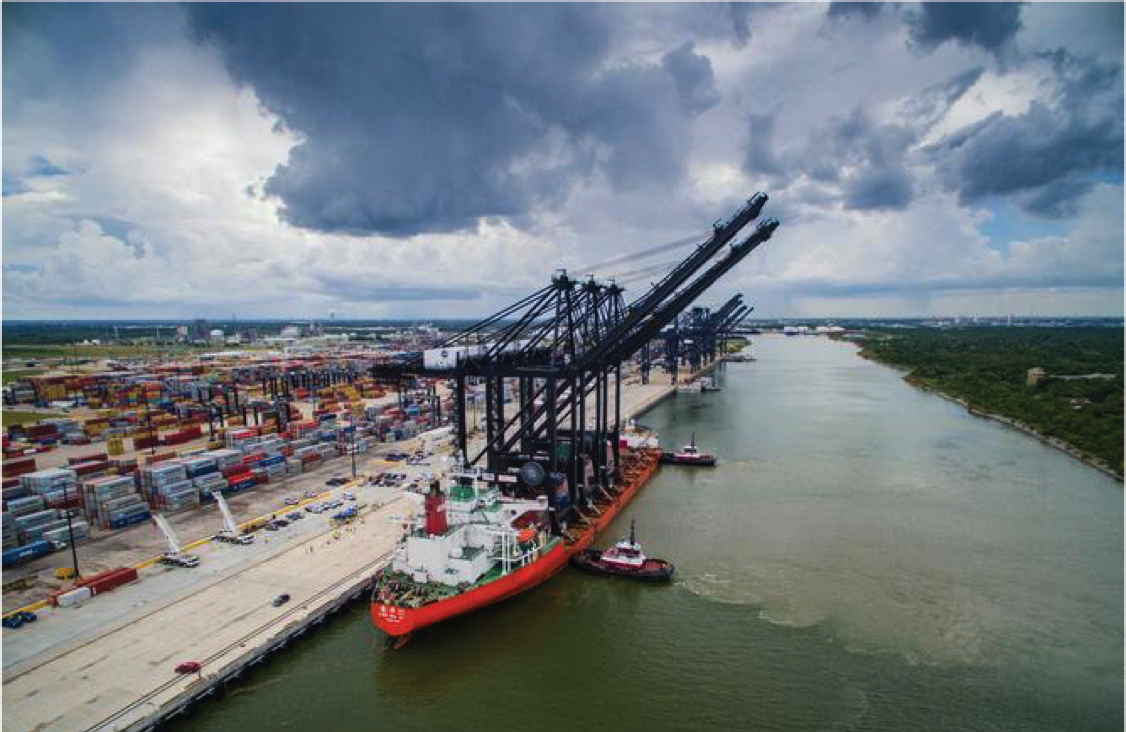
Project 11 continues to make significant progress. Port officials announced that dredging of the first segment known as Segment 1A, is complete. Project 11’s Segment 1A constitutes eleven and a half miles in the Bay. The expansion of this area is expected to help increase safety, reduce congestion, and improve vessel transit times by approximately an hour by reducing daylight restrictions.
The completion of segment 1A is a great step forward to sustaining the busiest waterway in the nation, it moves Port Houston one step closer to handling unrestricted two-way traffic of larger vessels. Project 11 is on track toward its goal of completion in 2025, an aggressive timeline that is necessary to accommodate the future needs of businesses and vessels.
New Cranes Arrive at Port Houston
Three new neo-Panamax STS cranes arrived at Port Houston’s Bayport Container Terminal this past February. The purchase and installation of these cranes represent a significant infrastructure investment for Port Houston.
The investment is the continued commitment to staying ahead of growth in the region. The cranes are the port’s biggest yet and will facilitate 15,000 TEU sized vessels that are anticipated to call terminals upon completion of the Houston Ship Channel Expansion – Project 11.
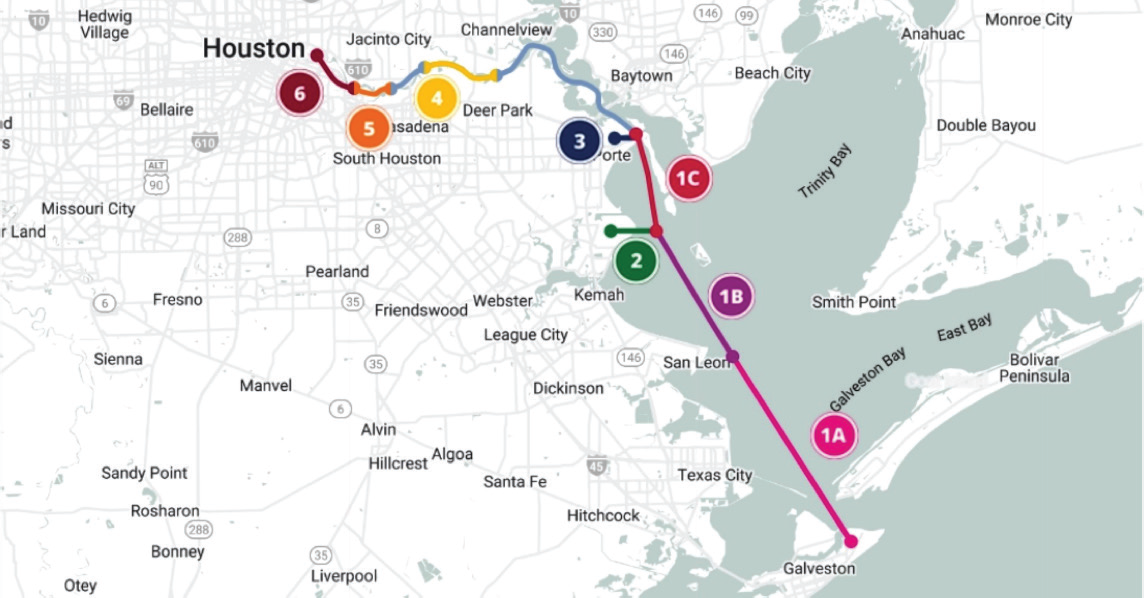
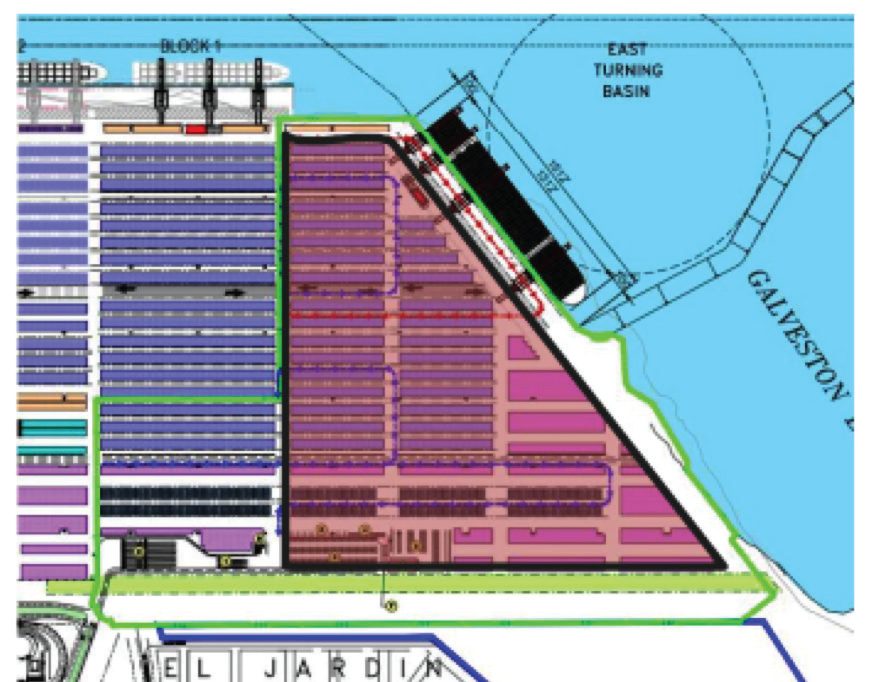
Container Yard Expansion at Bayport Container Terminal
To improve the efficient movement of goods to reduce ongoing disruptions to the supply chain, Port Houston plans to use 100 acres at the developed Bayport East End of the Bayport Container Terminal as an additional container yard. The additional space will accommodate increased container volumes, while improving terminal efficiency, supporting emissions reduction, and maintaining international trade.
The East End was originally developed as a cruise terminal, but its use was changed, in part, to an auto roll-on/roll-off terminal based on past market demands. To address current and projected future demands for container storage at Bayport, Port Houston now plans to change the use of the East End to a container yard that will include paving the existing auto terminal area and adjacent unpaved area to its south.
Petrochemicals form the backbone of the modern economy and are found in a wide range of consumer and industrial products, many of which are considered essential for daily use. Most individuals associate petrochemicals with plastics, but their potential uses span a much broader spectrum of applications. While petrochemical products in Houston have a global reach, they can be broken down to the simple terms of impacting everyday household goods that supply homes in the region, medical devices utilized by scenarios in the Texas Medical Center, to NASA developing components to explore outer space. Most people encounter more petrochemical end products than any other substance on the planet.
Project Pipeline
Economic Alliance is tracking 23 active projects in the pipeline with regional partners with a potential for USD $ 6.1B, 3,800 new job opportunities, and 300 retained jobs. Petrochemical and manufacturing make up 83% of the YTD ‘23 pipeline with alternative fuels, logistics, corporate headquarters, and real estate development combining for the remaining 17%.
Economic Alliance conducts an annual evaluation of the project pipeline to determine which of the projects are still viable and will evaluate the current pipeline in January ’23 to determine the status of projects and if they are still being considered for the Houston Port region.
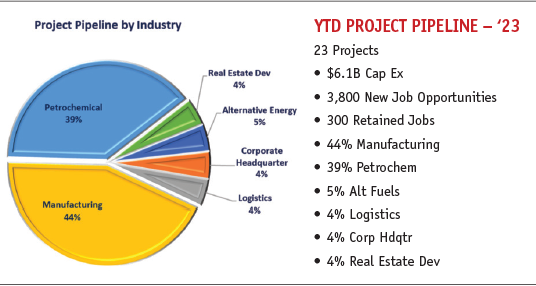

Activities from 2022
I -10 East Expansion/San Jacinto River Bridge – The Transportation Taskforce at the Economic Alliance has long advocated for a new I-10 bridge over the San Jacinto River and most recently TXDOT has included over USD $ 170 M of funding for a new I-10 Bridge in their Unified Transportation Program.
A new bridge will not only bring an end to the constant concerns with barge strikes, but it will also bring much-needed traffic relief to the region. The task- force will continue to monitor the project to ensure the project is adequately funded and completed on time.
Beltway 8 Bridge and Direct Connectors – The Transportation Taskforce at the Economic Alliance compiled a support letter that advocated for funding of all 8 direct connectors for the Beltway 8 Bridge, currently only 5 of 8 the connectors are funded.
- The support letter sent to key Officials at TXDOT, HGAC and HCRTA was signed by all Houston Port region Federal representatives, local State of Texas Senate and House representatives, Harris County Precinct 2 Commissioner, and all local Mayors urging the agencies to work together to find a solution for funding the 8 direct connectors.
Ultimately, the task force is making certain the Houston Port region is connecting mobility, safety, and environmental issues, economic opportunity, and unprecedented industry growth with current and future transportation and infrastructure projects.
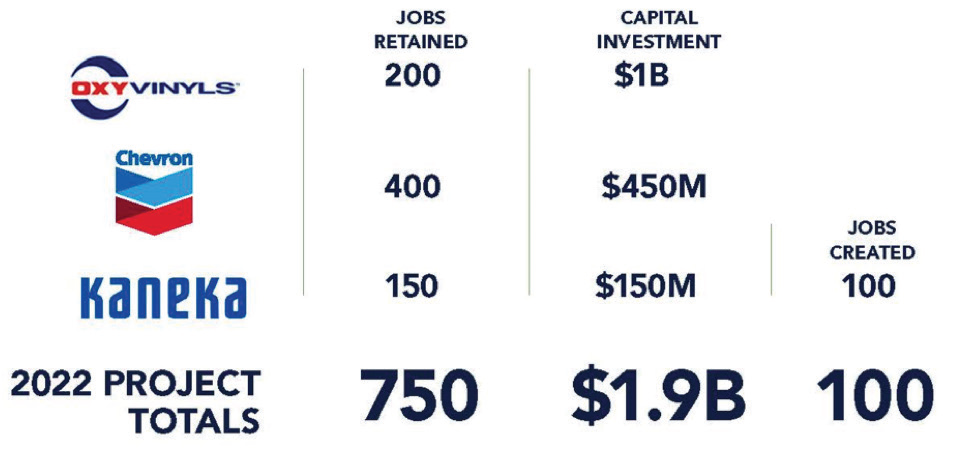

Conclusion
The mission of the Economic Alliance is simple – to support members and grow a vibrant regional economy.
Economic Alliance represents a significant voice and as a group, it is making a difference to provide a positive business climate in the Houston Port region as well as fostering growth in the region. It is the individuals, members, companies, partners, and municipalities, that convene and do the work to advance the Houston Port region globally. There is no other location in the world that provides the assets to support and grow a productive operation quite like the Houston Port region.


